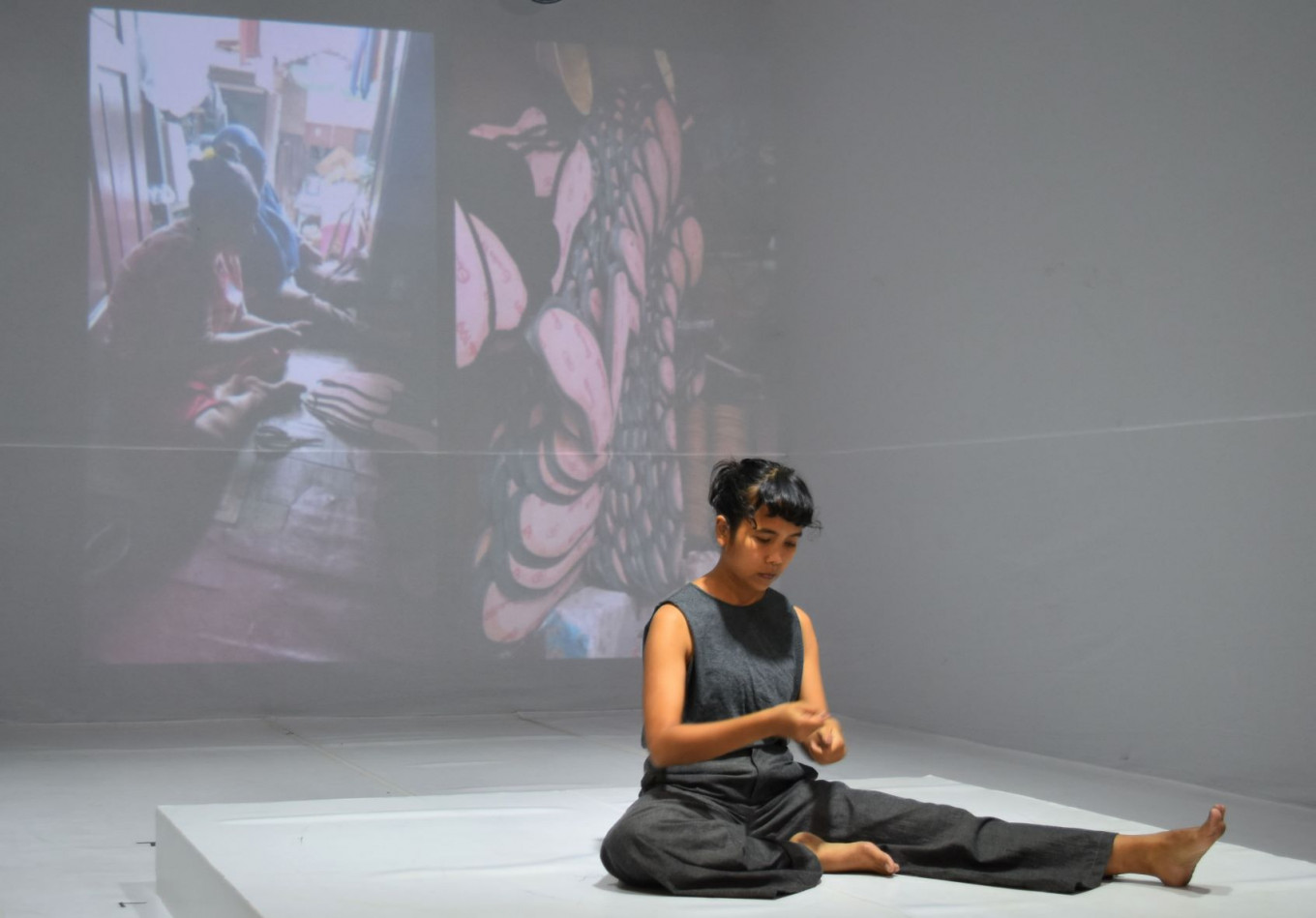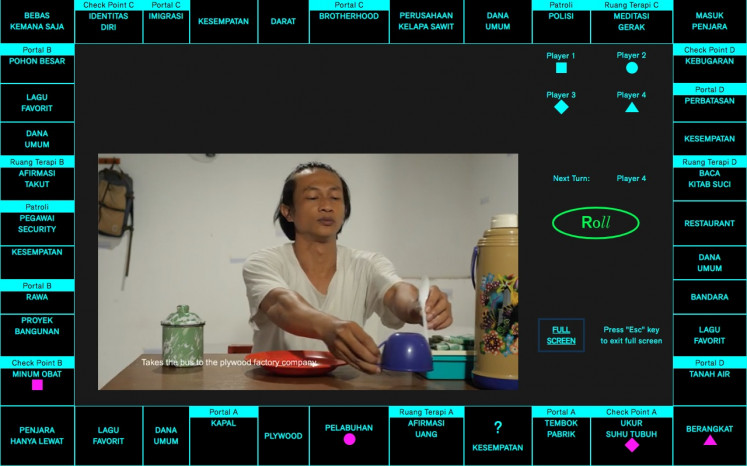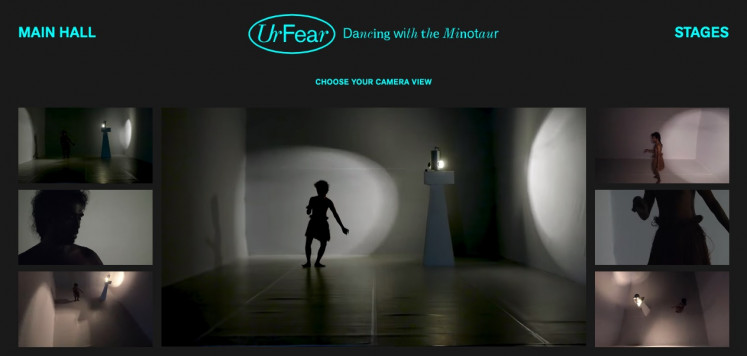‘Urfear: Huhu’ redefines live performance
Join an instant poll or roll a dice and see where the story takes you.
Change Size

T
he complete package of theatrical performances Urfear: Huhu and the Multitude of Peer Gynts pokes fun at what is perhaps the humans’ biggest fear: A walk into the unknown.
There is no warning that the virtual trip throughout the 10 performing arts could serve as mental support to face the unforeseeable future, or the end of the global crises in the wake of the COVID-19 pandemic.
Available on the website urfearmpg.net from Oct. 31 to Nov. 30, the presentation of the performances was smartly designed to give the audience control of how and at which point they would start this journey into the unknown.
Set up as a large board game, there are four stages available on the website, each of which would stimulates different emotions and senses we have forgotten over the past long months – the urge of taking chances.

Monopoly: Asylum Edition by mime actor Andreas Ari Dwianto was the mini version of the whole idea to give the audience the freedom to create their own story.
Roll a virtual dice to move around the “monopoly” board and, as a game piece stops in a certain box, a video will play.
As more videos pop up, the audience gets the story of Pirijin Samidi, a 25-year-old bachelor who left for Malaysia as an undocumented migrant worker.
He spends his days being chased by his own fear of getting caught by the authorities, but keeping normalcy by checking his body temperature, finding his favorite songs on the radio and, at times, loosening up.
The “digital algorithm” notifies players whether they get extra steps or lose a chance to another player, which raises the probability of watching the same video twice or more times.
The game would tick off those who love their things in order, but not the curious minds who have been trapped in their own mundane life.
The show is the final form of an Inter-Asia collaborative project initiated by Teater Garasi/Garasi Performance Institute director and producer Yudi Ahmad Tajudin and playwright Ugoran Prasad in 2018.
Based loosely on Act IV of allegorical drama Peer Gynt written in prose in Danish by Norwegian Henrik Ibsen and published in 1867, the project was among the recipients of Ibsen Scholarships in 2019.
The project, which investigates pluralism and intercultural connections, found its shape through two years of exploration and brainstorming among performing artists from Indonesia, Japan, Sri Lanka and Vietnam.
The original story follows the anti-hero titular character who sets overseas down to North Africa in search of himself and redemption, a prisoner to his fears of life and love. On one of his trips, he meets Huhu, who hails from the coast of Malabar, India – the key character in the project.
“This performing art network is a multifaceted interpretation of the drama, seen from the perspective of the global South represented by Huhu,” said Yudi at the opening night.
“It’s not far-fetched to say that the show reflects how Asia sees the rest of the world as a counter to how the rest of the world always defines Asia from their own perspective.”
The artists also involved in the show are Japanese performer Micari and sound designer Yasuhiro Morinaga, Sri Lankan choreographer Venuri Perera, the East Flores Theater Collective, Teater Garasi residents Andreas, Gunawan Maryanto, Arsita Iswardhani and MN Qomaruddin as well as Indonesian singer Nya Ina Raseuki, dancer Darlane Litaay and Makassar-based performer Abdi Karya.
Another collaborator in the project is visual artist Wok The Rock, or Woto Wibowo by birth name, who built the website.
“I’m excited to be in the project, because IT is not seen as a supporting aspect for the presentation but as an element in this collaboration. This is a challenging new experience for me,” he said, adding that it took him two months to complete the web construction in time for the artists to complete their works.
Similar to on-stage performances, the videos can only be seen at scheduled times.
Four to seven performances are available every day, except on the last day, when the audience can watch the whole performance.
Tickets are sold on the website for Rp 50,000 (US$3.39) to get full access, or $15 for the overseas audience. An option of Rp 300,000 for the local audience includes a merchandise T-shirt.
The modular design adopted for the show allows the audience to enjoy varied combinations of performances that generate a new experience every time.
While waiting for a show to start, videos of the collaborators play on loop copying some acts, such as eating, peeling the layers of an onion, or sporting a sarong over their heads.

The live interactive show The Messiah for Dummies by Gunawan Maryanto relies on the instant poll from the audience on what costume he should wear next as a false prophet, for example.
Litaay’s recorded Dance with the Minotaur has different camera angles for the audience to choose from, and the six-hour acousmatic sound arrangement by Morinaga and Nya Ina Raseuki, also known as Ubiet, also has optional features for the audience to hear the sound from ancient times.

A live performance lecture on the diegetic journey itself, The Origin(s) of Huhu, is presented by Abdi Karya, involving body expression and fun exercise using a sarong.
How the Ghost-Worker is Dancing in Your Shoes by Arsita Iswardhani shows her performing small movements in repetition for a good four hours, mimicking the female laborers in the fashion industry.
“The thread that connects all the modules is the new kind of fear and anxiety caused by the escalating global mobility,” said Yudi.
The immobility of self-isolated people and the high dependency on the internet in the pandemic are also well presented, which makes the audience accept that connection glitches are an integral part of the shows.
Urfear: Huhu and the Multitude of Peer Gynts offers a fresh experience in enjoying performing arts in which one could move along with the artists or while doing their daily activities. It has layered messages for the audience to find, to identify with and to confront their fears with. (ste)









